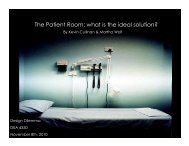The role of physical design and informal communication
The role of physical design and informal communication
The role of physical design and informal communication
Create successful ePaper yourself
Turn your PDF publications into a flip-book with our unique Google optimized e-Paper software.
<strong>The</strong> data collection period coincided with the graduate nurse’s formal orientation<br />
program. In this 12-week formal orientation period, graduate nurses are co-assigned<br />
with an experienced nurse preceptor who assists graduate nurses in their transition<br />
from the student <strong>role</strong> to the RN <strong>role</strong>. <strong>The</strong> graduate nurse’s orientation began the week<br />
<strong>of</strong> January 21st, all <strong>of</strong> which was spent in the classroom. It wasn’t until week two <strong>of</strong><br />
her orientation that she actually started working on the unit, at which point data<br />
collection began. <strong>The</strong> data collection period was intended to continue for 11weeks,<br />
concluding with the completion <strong>of</strong> the orientation program. However, because the<br />
study <strong>of</strong> 6N was done in conjunction with the study <strong>of</strong> another unit at the same<br />
hospital, both <strong>of</strong> which addressed the same research questions <strong>and</strong> used the same<br />
methodologies, data was only collected for 9 weeks because that was the time period<br />
in which the graduate nurse on the other unit was able to be observed, <strong>and</strong> the goal<br />
was to collect comparable data over the same time period.<br />
Before data collection could begin, IRB requirements m<strong>and</strong>ated that all 6N staff<br />
members be informed <strong>of</strong> the study <strong>and</strong> its purpose. To accomplish this, the researcher<br />
composed a memo briefly describing the study that was emailed to all 6N staff <strong>and</strong><br />
was posted in various locations throughout the unit (see Appendix A). Furthermore<br />
the nurse manager as well as the clinical nurse specialists (CNS) involved with the<br />
unit <strong>informal</strong>ly talked with staff to create awareness about the study. Obtaining<br />
graduate nurse <strong>and</strong> Orientor consent to participate in the study was also required by<br />
the IRB. To achieve this, one-on-one meetings were held with both subjects to<br />
describe the study <strong>and</strong> answer questions, at which point consent was received (see<br />
Appendix B for graduate nurse consent form; Appendix C for Staff consent form).<br />
In addition to satisfying IRB requirements, the researcher sought to develop a<br />
deeper underst<strong>and</strong>ing <strong>of</strong> the workings <strong>of</strong> the unit before data collection began.<br />
31







